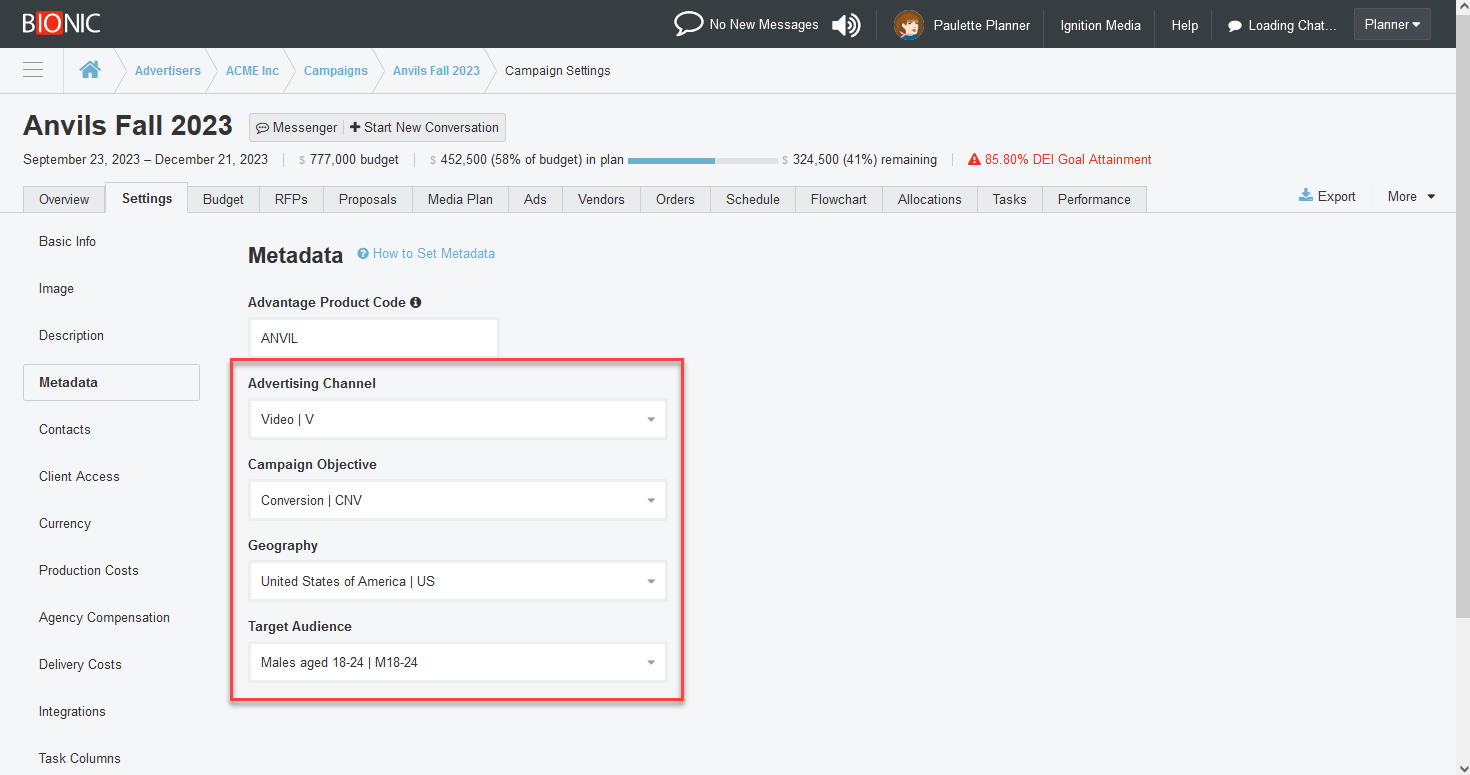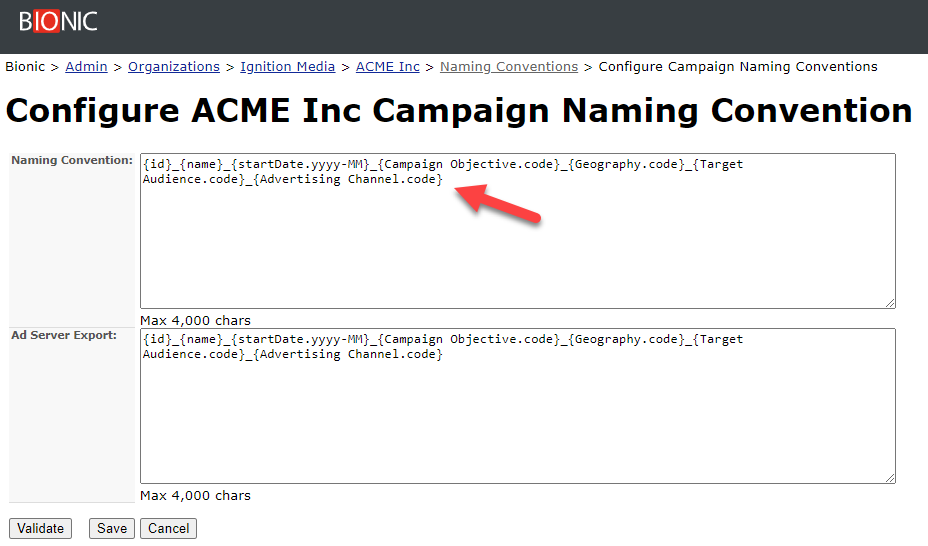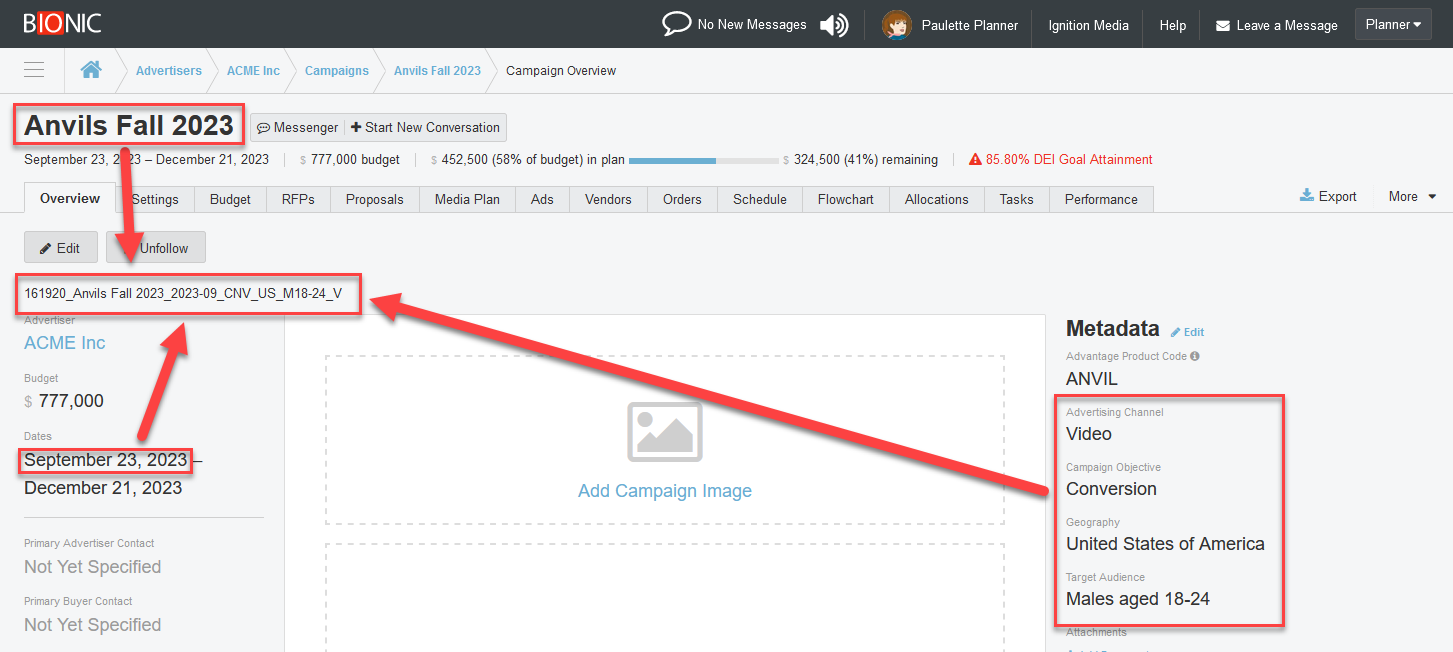You can finally ditch those spreadsheets with all the CONCATs and VLOOKUPs. Bionic now totally automates campaign naming conventions. Here’s how it works.
You can finally ditch those spreadsheets with all the CONCATs and VLOOKUPs. Bionic now totally automates campaign naming conventions. Here’s how it works.
What are Campaign Naming Conventions?
In digital advertising, campaign naming conventions are systematic ways of naming campaigns so they’re easily identifiable, organized, and trackable. A good naming convention will make reporting, optimization, and collaboration much more efficient.
Good naming conventions will also help you stay organized.
What Goes into a Campaign Naming Convention?
While there’s no one-size-fits-all naming convention, a common approach is to structure names in a way that captures the most relevant details about your campaign, such as:
Unique Identifier: A durable ID for this campaign that stays consistent regardless of other changes in the campaign data. This is the most important part of your naming convention. If you could only have one piece of data, this is it. Example: 161920. Name: The “friendly” human-readable name of the campaign. Example: Anvils Fall 2023. Time Period: The start date or date range of the campaign. Example: 2023-09 Objective: What the campaign aims to achieve. Examples: Awareness, Conversion, Retargeting, etc. Geography: The geographic target of the campaign. Examples: US, EU, Global, NYC, etc. Audience: Details about the target audience. Examples: M18-24 (Males aged 18-24), Retargeting_CartAbandoners, Lookalike_TopCustomers, etc. Channel: The channel for the campaign. Examples: Video, Display, Audio, Multi, etc. Version: If you’re testing different versions. Examples: v1, v2, TestA, TestB, etc. Other: Any other information that might be relevant to your specific needs. Examples: PromoCode, SpecialEvent, PartnershipName, etc.Encoding Campaign Naming Conventions
One of the challenges of naming conventions is packing it with a lot of information while making sure it doesn’t get too long. If it gets too long, you run the risk of losing information at the end of the name when you traffic your ads to ad servers and platforms.
To compress the advertising campaign naming conventions, you can encode long strings of text into short, standardized codes. For example, “United States” can be encoded as “US.”
Example of a Campaign Naming Convention
An example naming convention using the factors above might look something like:
161920_Anvils Fall 2023_2023-09_CNV_US_M18-24_V
This would denote a “Anvils Fall 2023” campaign ID 625528 running in September 2023, aiming for conversions, targeting males aged 18-24 in the US, using video, and it’s the first version of the campaign.
The Problems with Excel-Powered Naming Conventions
Ask any media team to show you their system for constructing campaign naming conventions. In many cases, they’ll show you an elaborate Excel workbook with dizzying CONCATENATE formulas with VLOOKUPs throughout.
While this technique is common and can produce the desired campaign naming conventions, it’s notoriously fraught with problems. Here are just a few.
Fragile
Perhaps the biggest problem with Excel-powered naming conventions is fragility.
It’s Excel. So, the user interface is limited to a spreadsheet with weak guardrails. It’s easy to break. It’s not a database. So, there’s no good way to create durable and unique campaign identifiers.
Basically, Excel was not built to reliably produce good naming conventions.
Disconnected
Excel-powered naming conventions are disconnected from your media planning and media buying processes. As a result, it requires a lot of re-keying back and forth between media plan, spreadsheet, and various ad servers and platforms.
This is a recipe for failure.
Inconsistent
Because this data is in many places when using Excel-powered naming conventions, data inconsistencies are inevitable. These errors propagate, accumulate, and pollute your downstream analytics.
When your data science team discovers these errors, they’ll report to management and point their fingers at you. The next meeting is not fun.
How to Automate Campaign Naming Conventions
At this point, you may be thinking “this would be easy to automate.”
It’s not as easy as you think. That’s why these spreadsheets still exist. However, your thinking is right on point – this really should be automated. If it can be done in Excel, it can be done in software.
As you already guessed, yes Bionic enables you to fully automate your campaign naming conventions along with placement naming conventions and creative naming conventions.
Add Missing Fields

One of the barriers to systematizing naming conventions through software is missing data fields. This forces you to turn to other tools like Excel that give you more flexibility.
Bionic gives the flexibility you need through Custom Fields Everywhere.
This enables you to enhance Bionic with your own proprietary picklists and other data fields. This opens the world of possibilities for naming conventions, integrations, and many other applications.
Establish Your Campaign Naming Conventions

Bionic has a built-in naming convention configuration tool that handles the complexities of naming conventions, such as:
Assigning unique IDs VLOOKUP-style decoding Date parsing and formatting Translating coded values Integrating custom fields Varying naming conventions by clientUse Your Campaign Naming Conventions

As soon your campaign naming conventions are configured, your media team will be using the latest specifications. No need to distribute. No training required. It’s built right into your media plan.
Whenever they change a date, picklist, or any other field that affects it, the campaign naming convention will automatically update. No need to swivel chair back and forth with a spreadsheet. It’s already done.
And when it comes time to traffic to your ad server or other platform, the campaign naming conventions are ready for export.
How to Get These Capabilities
If you’re already using Bionic for Agencies, you already have access to all the features above. Contact our customer support team and we’ll help you get started.
If you’re not yet on Bionic and want to try it, you can start a trial through our website.


